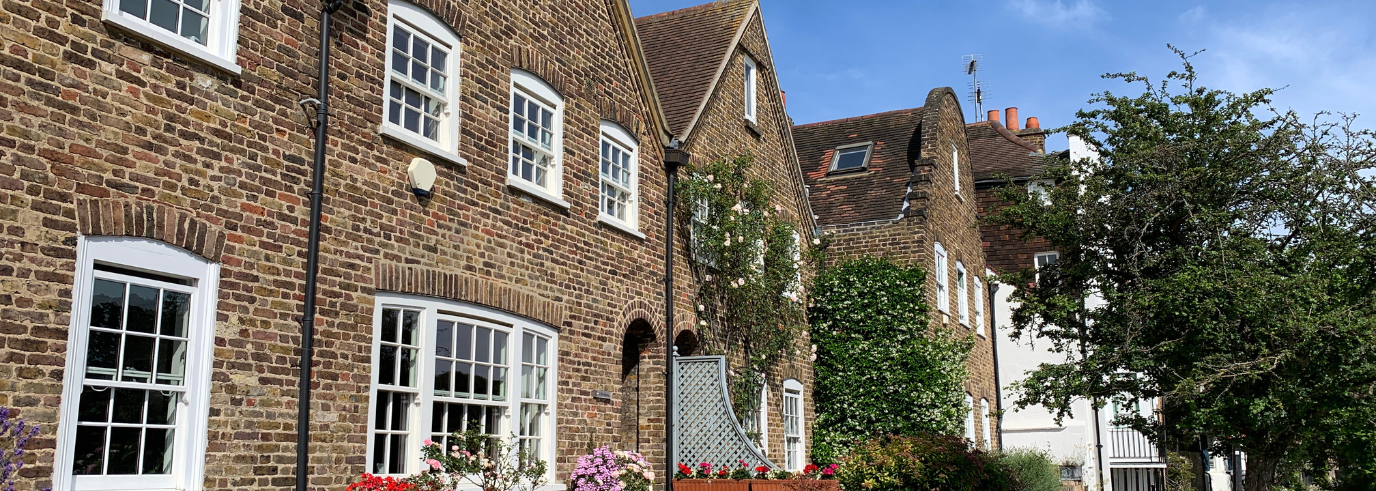
London neighbourhoods with historical appeal
We round up those historical architectural pockets of the Capital that have stood the test of time.
31 January, 2024
There are those areas in London where the past reveals its imprint on the present. From ancient Roman beginnings, to William the Conqueror’s establishment of the city as a seat of power, to surviving plagues, wars, Royal dynasties, and rapid urban growth during the Industrial Revolution, London has withstood centuries of change. And these echoes of the past have carved their mark on today’s cityscape, culminating in a glorious and harmonious mix of old and new.
Such is our Capital’s historic significance that it boasts four UNESCO World Heritage Sites.
But look beyond those public national treasures and you’ll also find an impressive roll-call of slightly more humble residential buildings, blocks and housing estates whose architectural importance is no less significant, and whose history can only elevate your postcode’s personality and desirability.
Historical housing estates
The Corbett Estate, SE6 and SE13
Tucked away in the heart of the Borough of Lewisham, a 15-minute walk from Catford and Hither Green mainline stations, is the perfectly preserved Corbett Estate. This cluster of late-Victorian and Edwardian villas and terraces was built by Scottish MP, philanthropist, and social housing reformer, Archibald Cameron Corbett between 1896 and 1911.
The 3,000 homes are laid out in neat rows, across 27 streets all with Scottish names. They were designed to offer the middle classes space, character and a sense of community, with easy access to central London from the newly constructed station, which called time on Hither Green’s quiet rural living in 1895.
Corbett was an entrepreneur who saw a business opportunity with the arrival of the railway. He had a vision of a respectable, church-going, sober society, so the estate had no pubs and instead offered six shopping parades, four schools, a recreation ground and a smattering of churches. Such was the estate’s desirability, it became one of the top places to live in London.
Sales Branch Director for KFH Catford Alex Hoadley can vouch for the fact that the estate remains a thriving community for families today. ‘The Corbett Estate has long been a symbol of elegance and prestige,’ he says. ‘Its appeal to buyers is undeniable as it offers a unique blend of history, architecture, and a strong community spirit.’
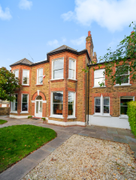
The Corbett Estate has long been a symbol of elegance and prestige.
The Lion Houses, The Peterborough Estate, SW6
With its café culture, sought-after schools, green spaces and excellent transport links, the Peterborough Estate Conservation Area just south of the New King’s Road and Parson’s Green is one of the most prestigious addresses in London.
These elaborately decorated red brick Victorian townhouses were erected on a former orchard and fields by Irishman and prolific builder Jimmy Nichols from 1890 onwards. And in a nod to the labourers who built them, the majority of the street names on the estate are named after their home towns in Kent.
But it’s one particular feature of these houses that have made them famous in the annals of architecture and have earned them the moniker ‘Lion Houses’ – the lion statues that preside over residents from their gabled parapets at roof level.
The story goes that Nichols ordered ten times as many of his trademark terracotta lions as he needed, hence the sheer number of lions that you can see on the estate. Look up as you stroll these avenues today and you’ll encounter the gaze of the lions, most of which are now painted white.
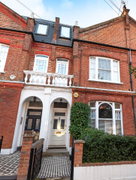
The Alexandra and Ainsworth Estate, NW8
With its colossal curve of concrete staggered terraces and 1,300ft long red brick walkway built beside the railway track into Euston, the Brutalist Alexandra and Ainsworth Estate in St John’s Wood has long been a favourite for location managers scouting for a dramatic backdrop for adverts, movies and music videos.
It was designed by revered Modernist architect Neave Brown, one of a world-class team of talented architects led by Sydney Cook who was appointed Borough Architect and Director of Housing for Camden council in the 1960s. He championed high density, low-rise duplexes with generous proportions, big windows, private outdoor spaces and communal gardens.
The ex-local authority estate is now considered one of the most architecturally important landmarks of British social housing. So much so, that it was awarded Grade II listed status by English Heritage in 1993, one of only a handful of post-war housing estates to be awarded such an accolade. In 2017, Neave himself was awarded the Royal Gold Medal of the Royal Institute of British Architects (RIBA) for the estate and is the only architect to have had all of his UK work listed.
Riverside conservation areas
Shad Thames, SE1
The characterful cobbled streets, converted brick Victorian storehouses and overhead goods gantries of Bermondsey’s Shad Thames which runs through Butler’s Wharf from Tower Bridge to St Saviour’s Dock are a living reminder of this historic riverside neighbourhood’s 19th century past as a major depot of wharves, warehouses and mills that housed coffee, tea and spices.
The last warehouses closed in 1972 when shipping containers abandoned the historic docks and unloaded their goods further east and the area fell into decline. Artists like David Hockney made the area fashionable for creative types in the 1970s, before developers cottoned on to its appeal in the 1980s and converted the industrial spaces to fashionable, loft-style apartments. Pivotal to its rebirth was iconic designer Terence Conran’s early endorsement of the neighbourhood when he unveiled his (now relocated) Design Museum there in 1989, as well as a cluster of riverside restaurants that included Le Pont de la Tour.
Today, buyers are drawn to Shad Thames and the wider Tower Bridge Conservation Area for its luxury living, foodie scene, thriving arts community, river views and its close proximity to the city, Canary Wharf, Borough Market and iconic sights like Tower Bridge and The Shard.
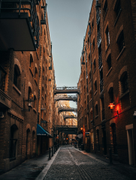
Strand on the Green is one of the most well established and oldest parts of Chiswick.
Strand on the Green, W4
Along the north bank of the Thames to the east of Kew Bridge is Strand on the Green. Once a tiny 13th century fishing community, it was one of Chiswick’s four medieval villages along with Old Chiswick, Turnham Green and Little Sutton that merged to become the present-day Chiswick. Today, it’s one of the most picturesque riverside hamlets in London.
The presence of the Royal Family at nearby Kew Palace and the construction of Kew Bridge in 1759 brought prestige and growth to the area. The city’s wealthy built grand houses and established their many industries along the waterfront. But by the 19th century, the building of the Grand Junction Canal took trade away, the Royal Family upped sticks for Windsor Castle and the area fell into decline, becoming a slum by the early 1900s. By a stroke of luck, many of the old buildings survived bombing in WWII and the 1947 Town and Country Planning Act resulted in the listing of 39 of its buildings, protecting them from demolition.The neighbourhood prospered once more and was finally awarded Conservation Area status in 2018.
KFH Chiswick Sales Branch Director, Liam Bray, agrees that it’s easy to fall in love with the area. ‘Strand on the Green is one of the most well established and oldest parts of Chiswick. Its picturesque, river-facing buildings make it one of the most prestigious roads and areas to live. Numerous properties are listed and for all the right reasons: they’re each individually unique, imposing and full of character, offering a rare glimpse of 18th century architecture that is otherwise lacking throughout W4.’
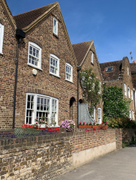
Notable building developments
Du Cane Court, SW17
Between 1935 and 1938 during the pre-war era of Art Deco decadence, Du Cane Court was built on Balham High Street. It’s testament to its design brilliance that this beacon of avant-garde living attracted artists like Dame Margaret Rutherford and Sir Alfred Hitchcock, and still houses a thriving residential community to this day.
The iconic block of 676 apartments once featured a ballroom, restaurant and members’ club - sadly destroyed by fire in 1945 - and was designed by George Bertram Carter. A triumph of Art Deco luxury, the apartments were ground-breaking for their time and were fitted out with polished black and white Italianate marble, terrazzo, mirrored surfaces, and leaded light windows over the front doors – some of which still exist today.
The distinctive symmetrical exterior features geometric brickwork, a central clock tower, a grand entrance hall with original revolving doors, and Japanese gardens by pioneering landscape gardener Seyemon Kusumoto. No surprise then that the block was the location for many episodes of Agatha Christie’s ‘Poirot’.
For a few years during WWII, the building was requisitioned by the government to house personnel and secret intelligence officers, and it has been speculated that the block escaped enemy bombing as it was earmarked for use as a British HQ by Nazi military officers in the event of a successful German invasion.
After falling into disrepair, the structure was restored to its original splendour in the 1980s and updated to suit modern lifestyles. Today, the sought-after apartments enjoy an on-site shop and a 24-hour concierge service.
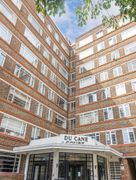
Harrods Village, SW13
Wander along the Thames Path between Fulham and Hammersmith Bridge, and you’re faced with the monumental, neo-classical grandeur of the Grade II listed Harrods Furniture Depository flanking the south bank of the river at Barnes.
Constructed on the site of an old soap works from 1911 to 1914, the former warehouse features ornate domed towers and a red and yellow brick frontage that was added by architect William George Hunt 20 years later. The huge space was used as a storage facility for the larger items that were too bulky to be housed in the famed Knightsbridge department store.
Converted in the late 1990s to a prestigious and gated estate, the landmark Baroque beauty has been renamed William Hunt Mansions and sits at the heart of 250 converted and new townhouses and penthouses called Harrods Village. As well as incredible Thames views and 10 acres of landscaped gardens, the exclusive enclave offers residents the use of a leisure centre with 25-metre pool, a gym, sauna, steam room and jacuzzi.
Looking for your own architectural home?
Speak to our local experts.